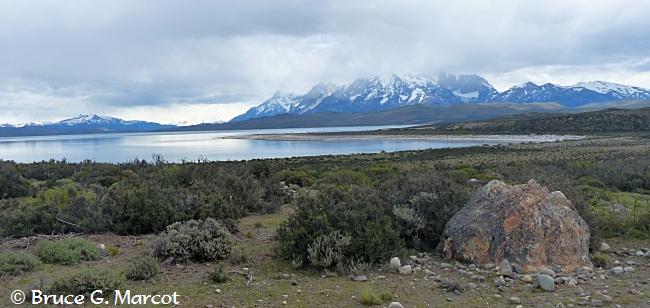|
Explanation: Here we
are at the end of another year. In the northern hemisphere it is winter,
and what better way to celebrate this season than this photo of snow on the
beach of a lake? But ...
this is not snow. Then what is it? We
are on the shores of Sarmiento Lake in beautiful Torres del Paine National
Park in southern Chile. To understand the white edging around the shore,
here is a major clue. The region belongs to the geological Cerro Toro
Formation of the Upper Cretaceous Period, comprised of deep, dense, turbid
marine sediments called turbidites. Turbidites form from
terrestrial sediments that once washed into the ocean by rivers, and then
compressed in massive quantities by underwater avalanches. Eventually,
the area became uplifted by mountain-forming tectonic pressures. OK
so far. 
The beautiful land and landscape around Sarmiento Lake is a major national
park.
But only the immediate shoreline is white ... why?
Here's
another clue. Sarmiento Lake has a pH of about 9, which is as alkaline
as baking soda and phosphate detergents. The lake is also hypersaline
-- extremely salty. These are clues that the lake acts like a playa,
that is, having no outlet, so that the only loss of water is through ground
percolation and evaporation which serves to concentrate the salts and increase
the salinity levels. So now
we can reveal the reason for the white shoreline. It is from the work of
blue green algae called cyanobacteria. These microorganisms use the high
saline content of the lake during their photosynthesis and produce a
precipitate of calcium carbonate that has a coral-like hard
"skeleton" structure known as microbialites. As the
microbialites increase in density and form, the minerals precipitate, creating
white macro-structures called thrombolites which appear like rounded rocks
covered in snow ... but they are neither rocks nor are they covered in
snow. They are masses of calcium carbonate covered by a thin surface
layer of living cyanobacteria still doing their job of creating yet more
microbialites and keeping the shoreline white. The
white formations around the shoreline are therefore thrombolities that, here,
have formed since the last glacial period that ended about ten thousand years
ago. The most
common cyanobacterium at Sarmiento Lake is Rivularia. The
cyanobacteria can proliferate here because the alkaline and hypersaline waters
are inhospitable to snails and other creatures that would otherwise feed on
them and keep them in check. And
now you know the amazing geological and biological secret behind the
"white snow" of Sarmiento Lake! It
is fitting, in this turn of another page on our calendar as we bid farewell to
the old and welcome in the new, that we have explored this land of ancient
geology and new life. Happy
New Life, Happy New Year everyone!

In the distance rise the three "towers" of Torres del Paine
National Park.
|
Index |
Location | Search | About EPOW | ... Next >